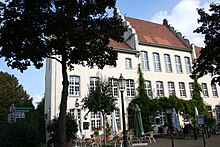Karthaus Xanten
The Karthaus Xanten is a former monastery of the Carthusian in Xanten . The Charterhouse was originally built in Flüren near Wesel in 1417 , but was moved to Xanten in 1628 .
history

The foundation of the Kartause Xanten goes back to Duke Adolf von Kleve , who from August 6th 1417 had a monastery built for 12 monks on the Rhine island op der Graven in Flüren near Wesel and donated it to the members of the Carthusian monks on February 2nd, 1419 . Johan van Delden and Albert Kivel had already been sent there as rector on June 11, 1418, but subsequently the General Chapter of the Carthusians did not agree to the foundation. It was only when Duke Adolf increased the foundation amount from 10,000 to 15,000 gold shields (scuta aurea) that the foundation deed was presented on February 2, 1419. In the letter of foundation, the naming of the island as insula reginae caeli (German: Island of the Queen of Heaven , called 'Our Women's Ward') was also specified and the monastery was consecrated to Mary , John the Baptist and the Evangelist John . The judicial transfer of ownership took place on January 7, 1420. In the same year the monastery was officially accepted into the Order of the Carthusians and Johan van Delden was elected prior ; shortly afterwards the monastery was expanded and offered space for 24 members of the order. When Duke Adolf, who put the monastery under his personal protection in 1426, died in 1448, he was buried in the monastery church.
During the Eighty Years' War the monastery was occupied by both Spanish and, a little later, Dutch troops. After Wesel joined the Reformation in 1540 , the monastery of the Catholic Carthusians was partially damaged in 1583 by attacks by Protestant citizens. The poorly restored monastery was then occupied again by Spanish troops in 1587, after having been taken by English troops the year before . In 1590, the monastery was finally abandoned after large parts of the monastery had also been destroyed when the island was de-fortified at the request of the city of Wesel. The bones of Duke Adolf, who was buried in the monastery church, were then taken to the Dominican monastery in Wesel, where the prior of the abandoned Carthusian monastery also found accommodation. After a short time, however, part of the nearby Augustinian monastery was assigned to the Carthusians .
In 1628 the Carthusian monks left Wesel due to the religious situation within the city and settled in Xanten, a few kilometers away, although the city lords did not want to build another monastery in Xanten besides the existing monasteries and the cathedral chapter . The attempt to prevent the Carthusians from building the monastery by prohibiting the clergy from acquiring land failed when the Brandenburg rulers voted in favor of the Carthusian settlements.
On December 9th, the so-called "Bratenberg'sche possessions" in the city center were acquired, shortly afterwards a house in Rheinstrasse as well as other properties. Finally a convent with 8 cells was created. The "Karthaus" was moved into almost 100 meters away from the Xanten cathedral chapter . In 1647 the Carthusian monks were given permission to use the St. Andrew's Chapel; the handover took place on February 6, 1648 with the proviso that the chapel should be returned to the Viktorstift in the event that the Carthusian monastery was abandoned. In addition, the vicar was to hold a weekly mass there and the Carthusians were to take care of the maintenance of the chapel. In 1749 the Carthusian monastery acquired the Andreaskirchhof, which it had surrounded with a wall in consultation with the Viktorstift, as well as two additional gardens in the city park surrounding Xanten.
In 1802, the monastery was finally closed in the course of secularization under Napoléon Bonaparte , the monastery library was transferred to the Xanten Abbey Library and the St. Andrew's Chapel was demolished. The remaining Carthusians returned to the Insel op der Graven , where Peter Etzweiler died as the last member of the Carthusian monastery in 1835 in the “Wardtmannshaus”. The Xanten Charterhouse came into private ownership and from there into the possession of the city of Xanten; while the restaurant “Einstein” was set up in the lower part of the “Karthaus” at the end of the 20th century, the upper floors of the Charterhouse housed the “Xanten City Library”.
Since December 2017 there is a combination of restaurant and bar with outdoor catering in the lower part of the building.
literature
- Robert Scholten : The Carthusian monastery Insula Reginae Caeli on the Grave near Wesel. In: Annals of the Historical Association for the Lower Rhine 52 (1891), pp. 61-136 ( digitized version )
- Harald Goder: Wesel , in: Monasticon Cartusiense , ed. by Gerhard Schlegel, James Hogg, Volume 2, Salzburg 2004, 630–637; as well as article Xanten , ibid. 660-665.
Web links
Individual evidence
- ↑ karthaus-xanten.de: About us. Retrieved December 8, 2017 (German).
Coordinates: 51 ° 39 ′ 46.8 " N , 6 ° 27 ′ 16.4" E

